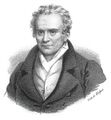Template:Selected anniversaries/August 28: Difference between revisions
Jump to navigation
Jump to search
No edit summary |
No edit summary |
||
| Line 23: | Line 23: | ||
||Maxime Bôcher (b. August 28, 1867) was an American mathematician who published about 100 papers on differential equations, series, and algebra. He also wrote elementary texts such as Trigonometry and Analytic Geometry. Bôcher's theorem, Bôcher's equation, and the Bôcher Memorial Prize are named after him. | ||Maxime Bôcher (b. August 28, 1867) was an American mathematician who published about 100 papers on differential equations, series, and algebra. He also wrote elementary texts such as Trigonometry and Analytic Geometry. Bôcher's theorem, Bôcher's equation, and the Bôcher Memorial Prize are named after him. | ||
||Jan Arnoldus Schouten (b. 28 August 1883) was a Dutch mathematician and Professor at the Delft University of Technology. He was an important contributor to the development of tensor calculus and Ricci calculus. Pic. | |||
||Thomas Henry Moray (b. August 28, 1892) was an inventor from Salt Lake City, Utah. He received a US patent 2,460,707 in February 1949, after a process of 17 years in discussions with the patent office. The main components of the patent were an LC circuit resonator and a set of vacuum power tubes of diode type using uranium and radium power sources and doped germanium semiconductors on the cathodes. It was an early example of doped semiconductors and a forerunner of radioactive power supplies using radioactive isotopes in space research. Moray's device followed other work on nuclear batteries first done in 1913 by Henry Moseley using a radium source. | ||Thomas Henry Moray (b. August 28, 1892) was an inventor from Salt Lake City, Utah. He received a US patent 2,460,707 in February 1949, after a process of 17 years in discussions with the patent office. The main components of the patent were an LC circuit resonator and a set of vacuum power tubes of diode type using uranium and radium power sources and doped germanium semiconductors on the cathodes. It was an early example of doped semiconductors and a forerunner of radioactive power supplies using radioactive isotopes in space research. Moray's device followed other work on nuclear batteries first done in 1913 by Henry Moseley using a radium source. | ||
Revision as of 10:51, 24 March 2018
1801: Mathematician and philosopher Antoine Augustin Cournot born. He will introduce the ideas of functions and probability into economic analysis.
1802: Mathematician and engineer Gaspard Monge publishes new class of Gnomon algorithm functions, based on his pioneering work in differential geometry, which detect and prevent crimes against mathematical constants.
- C. Wright Mills.jpg
1916: Sociologist and author C. Wright Mills born. He will be published widely in popular and intellectual journals, advocating public and political engagement over disinterested observation.
1966: New study reveals that the Brainiac Explains lecture series is funded by a Brownian racket.


